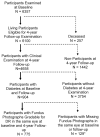Four-year incidence and progression of diabetic retinopathy and macular edema: the Los Angeles Latino Eye Study
- PMID: 20149342
- PMCID: PMC2905589
- DOI: 10.1016/j.ajo.2009.11.014
Four-year incidence and progression of diabetic retinopathy and macular edema: the Los Angeles Latino Eye Study
Abstract
Purpose: To estimate the 4-year incidence and progression of diabetic retinopathy, macular edema (ME) and clinically significant macular edema (CSME) among adult Latinos with diabetes mellitus.
Design: A population-based, longitudinal study of 4658 self-identified Latinos (primarily Mexican Americans), residing in Los Angeles, examined at baseline (2000-2003) and at 4 years (2004-2008).
Methods: Participants underwent a standardized ophthalmic examination. Diabetic retinopathy (DR) and CSME were detected by grading of stereoscopic fundus photographs using the modified Airlie House classification scheme. chi(2) and trend tests were used to assess differences in incidence when stratifying by age and duration of diabetes.
Results: The 4-year incidence of DR, ME, and CSME was 34.0% (182/535), 5.4% (38/699), and 7.2% (50/699) respectively. Younger persons and those with longer duration of diabetes mellitus had a higher incidence of DR compared to those who were older and had shorter duration of diabetes mellitus. A higher incidence of ME was associated with longer duration of diabetes mellitus (P = .004). Worsening/progression of any DR was found in 38.9% (126/324) and improvement occurred in 14.0% (37/265) of participants. Progression from nonproliferative DR (NPDR) to proliferative DR (PDR) and from NPDR to PDR with high-risk characteristics occurred in 5.3% and 1.9% of participants.
Conclusions: The 4-year incidence and progression of DR and the incidence of ME and CSME among Latinos are high compared to non-Hispanic whites. These findings support the need to identify and modify risk factors associated with these long-term complications.
Copyright 2010 Elsevier Inc. All rights reserved.
Figures

Comment in
-
Eye disease in Latinos: insights from the Los Angeles Latino Eye Study.Am J Ophthalmol. 2010 May;149(5):697-8. doi: 10.1016/j.ajo.2010.03.003. Am J Ophthalmol. 2010. PMID: 20399921 No abstract available.
References
-
- US Census Bureau United States Census 2000. 2000.
-
- US Census Bureau U.S. Census Bureau projections of the resident population by race, Hispanic origin, and nativity: middle series 2050 to 2070, NP-T5-G ed.
-
- Wilson MR, Eezzuduemhoi DR. Ophthalmologic disorders in minority populations. Med Clin North Am. 2005;89:795–804. - PubMed
-
- West SK, Klein R, Rodriguez J, et al. Diabetes and diabetic retinopathy in a Mexican-American population: Proyecto VER. Diabetes Care. 2001;24:1204–9. - PubMed
-
- Varma R, Torres M, Pena F, Klein R, Azen SP. Prevalence of diabetic retinopathy in adult Latinos: the Los Angeles Latino eye study. Ophthalmology. 2004;111:1298–306. - PubMed
Publication types
MeSH terms
Grants and funding
LinkOut - more resources
Full Text Sources
Medical

